同济大学:《经济学》课程教学资源(教案讲义)Ch11 National Income Accounting
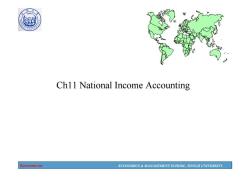
1907 Ch11 National Income Accounting Economics ECONOMICS MANAGEMENT SCHOOL,TONGJI UNIVERSITY
Economics ECONOMICS & MANAGEMENT SCHOOL, TONGJI UNIVERSITY Ch11 National Income Accounting
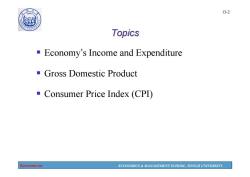
13-2 0 例 Topics Economy's Income and Expenditure Gross Domestic Product Consumer Price Index(CPI) Economics ECONOMICS MANAGEMENT SCHOOL,TONGJI UNIVERSITY
Economics ECONOMICS & MANAGEMENT SCHOOL, TONGJI UNIVERSITY 13-2 Topics Economy’s Income and Expenditure Gross Domestic Product Consumer Price Index (CPI)
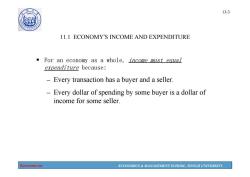
190 13-3 3树 11.1 ECONOMY'S INCOME AND EXPENDITURE For an economy as a whole,income must equal expenditure because: -Every transaction has a buyer and a seller. Every dollar of spending by some buyer is a dollar of income for some seller. Economics ECONOMICS MANAGEMENT SCHOOL,TONGJI UNIVERSITY
Economics ECONOMICS & MANAGEMENT SCHOOL, TONGJI UNIVERSITY 13-3 11.1 ECONOMY’S INCOME AND EXPENDITURE For an economy as a whole, income must equal expenditure because: – Every transaction has a buyer and a seller. – Every dollar of spending by some buyer is a dollar of income for some seller
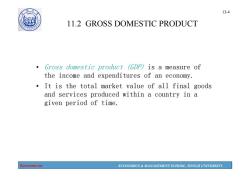
13-4 0 11.2 GROSS DOMESTIC PRODUCT Gross domestic product (GDP)is a measure of the income and expenditures of an economy. It is the total market value of all final goods and services produced within a country in a given period of time. Economics ECONOMICS MANAGEMENT SCHOOL,TONGJI UNIVERSITY
Economics ECONOMICS & MANAGEMENT SCHOOL, TONGJI UNIVERSITY 13-4 11.2 GROSS DOMESTIC PRODUCT • Gross domestic product (GDP) is a measure of the income and expenditures of an economy. • It is the total market value of all final goods and services produced within a country in a given period of time
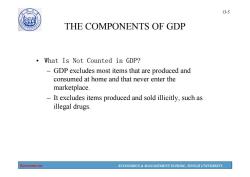
490 13-5 THE COMPONENTS OF GDP What Is Not Counted in GDP? -GDP excludes most items that are produced and consumed at home and that never enter the marketplace. -It excludes items produced and sold illicitly,such as illegal drugs. Economics ECONOMICS MANAGEMENT SCHOOL,TONGJI UNIVERSITY
Economics ECONOMICS & MANAGEMENT SCHOOL, TONGJI UNIVERSITY 13-5 THE COMPONENTS OF GDP • What Is Not Counted in GDP? – GDP excludes most items that are produced and consumed at home and that never enter the marketplace. – It excludes items produced and sold illicitly, such as illegal drugs

13-6 10 THE COMPONENTS OF GDP GDP ()is the sum of the following: Consumption (C) -Investment 1) Government Purchases (G) -Net Exports NX) Y=C+I +G+NX where Y=GDP the value of total output C+I +G NX aggregate expenditure Economics ECONOMICS MANAGEMENT SCHOOL,TONGJI UNIVERSITY
Economics ECONOMICS & MANAGEMENT SCHOOL, TONGJI UNIVERSITY 13-6 THE COMPONENTS OF GDP • GDP (Y) is the sum of the following: – Consumption (C) – Investment (I) – Government Purchases (G) – Net Exports (NX) Y = C + I + G + NX where Y = GDP = the value of total output C + I + G + NX = aggregate expenditure
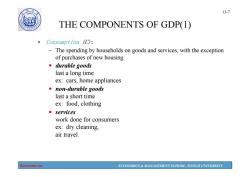
13-7 490 THE COMPONENTS OF GDP(1) Consumption (C): The spending by households on goods and services,with the exception of purchases of new housing ·durable goods last a long time ex:cars,home appliances ●non-durable goods last a short time ex:food,clothing ●services work done for consumers ex:dry cleaning, air travel. Economics ECONOMICS MANAGEMENT SCHOOL,TONGJI UNIVERSITY
Economics ECONOMICS & MANAGEMENT SCHOOL, TONGJI UNIVERSITY 13-7 THE COMPONENTS OF GDP(1) • Consumption (C): – The spending by households on goods and services, with the exception of purchases of new housing. • durable goods last a long time ex: cars, home appliances • non-durable goods last a short time ex: food, clothing • services work done for consumers ex: dry cleaning, air travel

13-8 0 THE COMPONENTS OF GDP2) Investment (I): -The spending on capital equipment,inventories,and structures, including new housing. Includes: .business fixed investment spending on plant and equipment that firms will use to produce other goods services .residential fixed investment spending on housing units by consumers and landlords inventory investment the change in the value of all firms'inventories Economics ECONOMICS MANAGEMENT SCHOOL,TONGJI UNIVERSITY
Economics ECONOMICS & MANAGEMENT SCHOOL, TONGJI UNIVERSITY 13-8 • Investment (I): – The spending on capital equipment, inventories, and structures, including new housing. Includes: • business fixed investment spending on plant and equipment that firms will use to produce other goods & services • residential fixed investment spending on housing units by consumers and landlords • inventory investment the change in the value of all firms’ inventories THE COMPONENTS OF GDP(2)
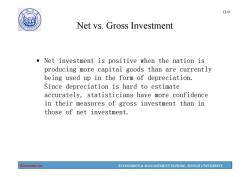
190 13-9 Net vs.Gross Investment Net investment is positive when the nation is producing more capital goods than are currently being used up in the form of depreciation. Since depreciation is hard to estimate accurately,statisticians have more confidence in their measures of gross investment than in those of net investment. Economics ECONOMICS MANAGEMENT SCHOOL,TONGJI UNIVERSITY
Economics ECONOMICS & MANAGEMENT SCHOOL, TONGJI UNIVERSITY 13-9 Net vs. Gross Investment • Net investment is positive when the nation is producing more capital goods than are currently being used up in the form of depreciation. Since depreciation is hard to estimate accurately, statisticians have more confidence in their measures of gross investment than in those of net investment
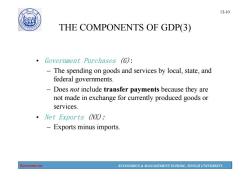
13-10 0 THE COMPONENTS OF GDP3) 。 Government Purchases (G): -The spending on goods and services by local,state,and federal governments. Does not include transfer payments because they are not made in exchange for currently produced goods or services. ·Net Exports (NX): -Exports minus imports. Economics ECONOMICS MANAGEMENT SCHOOL,TONGJI UNIVERSITY
Economics ECONOMICS & MANAGEMENT SCHOOL, TONGJI UNIVERSITY 13-10 THE COMPONENTS OF GDP(3) • Government Purchases (G): – The spending on goods and services by local, state, and federal governments. – Does not include transfer payments because they are not made in exchange for currently produced goods or services. • Net Exports (NX): – Exports minus imports
按次数下载不扣除下载券;
注册用户24小时内重复下载只扣除一次;
顺序:VIP每日次数-->可用次数-->下载券;
- 同济大学:《经济学》课程教学资源(教案讲义)Ch09 Externalities and Public Goods.pdf
- 同济大学:《经济学》课程教学资源(教案讲义)Ch10 Overview of Macroeconomics.pdf
- 同济大学:《经济学》课程教学资源(教案讲义)Ch08 Market For Factors of Production.pdf
- 同济大学:《经济学》课程教学资源(教案讲义)Ch07 General Equilibrium and Economic Efficiency.pdf
- 同济大学:《经济学》课程教学资源(教案讲义)Ch06-2 Imperfect Competition.pdf
- 同济大学:《经济学》课程教学资源(教案讲义)Ch06-1 Analysis of Perfectly Competitive Markets.pdf
- 同济大学:《经济学》课程教学资源(教案讲义)Ch05 Analysis of Cost.pdf
- 同济大学:《经济学》课程教学资源(教案讲义)Ch04 Producer Behavior.pdf
- 同济大学:《经济学》课程教学资源(教案讲义)Ch03 Demand and Consumer Behavior.pdf
- 同济大学:《经济学》课程教学资源(教案讲义)Ch02-2 Applications of Supply and Demand.pdf
- 同济大学:《经济学》课程教学资源(教案讲义)Ch02-1 Supply and Demand.pdf
- 同济大学:《经济学》课程教学资源(教案讲义)Ch01 The Fundamentals of Economics(负责人:李永).pdf
- 同济大学:《经济学》课程教学资源(试卷习题)期终考试试卷(B卷)答案.pdf
- 同济大学:《经济学》课程教学资源(试卷习题)期终考试试卷(B卷)试题.pdf
- 同济大学:《经济学》课程教学资源(试卷习题)期终考试试卷(A卷)答案.pdf
- 同济大学:《经济学》课程教学资源(试卷习题)期终考试试卷(A卷)试题.pdf
- 安徽科技学院:《会计信息系统》课程教学资源(PPT课件)第七章 ERP应用概述.ppt
- 安徽科技学院:《会计信息系统》课程教学资源(PPT课件)第六章 会计信息系统审计.ppt
- 安徽科技学院:《会计信息系统》课程教学资源(PPT课件)第五章 会计信息系统的建设与管理.ppt
- 安徽科技学院:《会计信息系统》课程教学资源(PPT课件)第四章 其他业务核算子系统.ppt
- 同济大学:《经济学》课程教学资源(教案讲义)Ch12-1 Consumption and Investment.pdf
- 同济大学:《经济学》课程教学资源(教案讲义)Ch12-2 The Determination of Equilibrium Output.pdf
- 同济大学:《经济学》课程教学资源(教案讲义)Ch13 Money Market Equilibrium.pdf
- 同济大学:《经济学》课程教学资源(教案讲义)Ch14 Outputs and Money Market - IS-LM Model.pdf
- 同济大学:《经济学》课程教学资源(教案讲义)Ch15 Aggregate Demand And Supply.pdf
- 同济大学:《经济学》课程教学资源(教案讲义)Ch16 Economic Growth.pdf
- 吉林大学:《中央银行业务管理》课程教学资源(PPT课件)第一章 中央银行制度的形成和发展.ppt
- 吉林大学:《中央银行业务管理》课程教学资源(PPT课件)第七章 中央银行的其他业务.ppt
- 吉林大学:《中央银行业务管理》课程教学资源(PPT课件)第三章 中央银行业务活动的法规原则与资产负债表.ppt
- 吉林大学:《中央银行业务管理》课程教学资源(PPT课件)第九章 中央银行货币政策的目标与工具.ppt
- 吉林大学:《中央银行业务管理》课程教学资源(PPT课件)第二章 中央银行在现代经济体系中的地位与作用.ppt
- 吉林大学:《中央银行业务管理》课程教学资源(PPT课件)第五章 中央银行的资产业务.ppt
- 吉林大学:《中央银行业务管理》课程教学资源(PPT课件)第八章 中央银行货币政策概述.ppt
- 吉林大学:《中央银行业务管理》课程教学资源(PPT课件)第六章 中央银行的支付清算业务.ppt
- 吉林大学:《中央银行业务管理》课程教学资源(PPT课件)第十一章 中央银行的金融监管.ppt
- 吉林大学:《中央银行业务管理》课程教学资源(PPT课件)第十二章 中央银行与外汇管理.ppt
- 吉林大学:《中央银行业务管理》课程教学资源(PPT课件)第十章 货币政策的作用机制.ppt
- 吉林大学:《中央银行业务管理》课程教学资源(PPT课件)第四章 中央银行的负债业务.ppt
- 吉林大学:《中央银行业务管理》课程教学资源(PPT课件)中央银行学课程总结与辅导(共十二章,负责人:齐艺莹).ppt
- 吉林大学:《宏观经济学》课程j电子教案(PPT课件)第一章 宏观经济学导论(负责人:赵静杰).ppt
